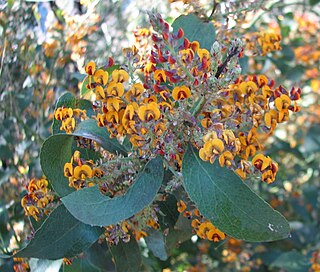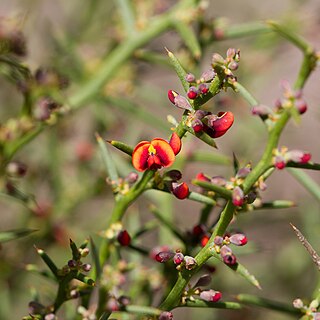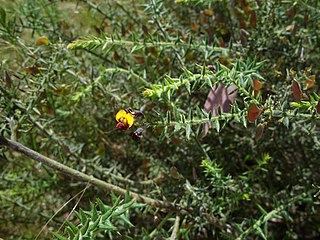
Daviesia horrida, commonly known as prickly bitter-pea, is a species of flowering plant in the family Fabaceae and is endemic to the south-west of Western Australia. It is a spreading shrub with rigid, spiny branchlets, narrowly elliptic phyllodes and orange and dark red flowers.

Daviesia ulicifolia, commonly known as gorse bitter-pea, is a species of flowering plant in the family Fabaceae and is endemic to south-eastern Australia. It is a rigid, openly-branched shrub with sharply-pointed, narrow elliptic, narrow egg-shaped, rarely egg-shaped phyllodes and usually orange-yellow and dark red flowers.

Daviesia leptophylla, commonly known as narrow-leaf bitter-pea, is a species of flowering plant in the family Fabaceae and is endemic to south-eastern continental Australia. It is a broom-like, multi-stemmed shrub with dull, yellowish-green, linear phyllodes and bright yellow flowers with maroon markings.

Daviesia latifolia, commonly known as hop bitter-pea, is a species of flowering plant in the family Fabaceae and is endemic to south-eastern Australia. It is a slender, erect, spreading shrub with elliptic, egg-shaped or lance-shaped phyllodes and orange-yellow and maroon flowers in long racemes.

Daviesia mimosoides, commonly known as blunt-leaf bitter-pea, narrow-leaf bitter pea or leafy bitter-pea, is a species of flowering plant in the family Fabaceae and is endemic to eastern continental Australia. It is an open shrub with tapering, linear, elliptic or egg-shaped phyllodes, and groups of orange-yellow and dark brownish-red to maroon flowers.

Daviesia arborea, commonly known as golden pea or bitterleaf pea, is a species of flowering plant in the family Fabaceae and is endemic to eastern Australia. It is a shrub or small tree with weeping branches, linear phyllodes and yellow flowers with red markings.

Daviesia arenaria, commonly known as sandhill bitter-pea, is a species of flowering plant in the family Fabaceae and is endemic to south-eastern continental Australia. It is usually a hummock-forming shrub with many short, spiny branchlets and heart-shaped to elliptic phyllodes with a sharp point on the end, and orange-pink, maroon and yellow flowers.

Daviesia devito is a species of flowering plant in the family Fabaceae, endemic to south-eastern continental Australia. It is a dense, prickly shrub with sharply-pointed phyllodes and yellow, red, greenish and maroon flowers. It was previously known as Daviesia benthamii subsp. humilis until that subspecies was split into two new species.
Daviesia schwarzenegger is a species of flowering plant in the family Fabaceae and is endemic to south-eastern continental Australia. It is a dense, mounded shrub with sharply-pointed phyllodes and yellow and dark red flowers, and resembles Daviesia devito apart from its more robust growth habit and the surface of its dried foliage.
Daviesia eremaea is a species of flowering plant in the family Fabaceae and is endemic to central Australia. It is an erect, glabrous, multi-stemmed shrub with needle-like, more or less sharply-pointed phyllodes, and yellow and red flowers.
Daviesia eurylobos is a species of flowering plant in the family Fabaceae and is endemic to the south-west of Western Australia. It is a spreading shrub with somewhat crowded, egg-shaped to elliptic phyllodes, and yellow and red flowers.

Daviesia laevis is a species of flowering plant in the family Fabaceae and is endemic to the Grampians in Victoria, Australia. It is an open, erect shrub with arching branchlets, scattered narrow elliptic to linear phyllodes and orange-yellow and brownish-red flowers.

Daviesia pauciflora is a species of flowering plant in the family Fabaceae and is endemic to the south of Western Australia. It is an open shrub with many stems, flattened, linear phyllodes, and mostly yellow flowers with red, orange and dull brownish markings.
Daviesia pectinata, commonly known as thorny bitter-pea, is a species of flowering plant in the family Fabaceae and is endemic to south-eastern continental Australia. It is a dense, rigid shrub with erect, flattened branchlets, crowded, flattened, triangular phyllodes, and yellow to orange and reddish flowers.

Daviesia pedunculata is a species of flowering plant in the family Fabaceae and is endemic to south-western Western Australia. It is a spreading or sprawling to erect shrub with erect, egg-shaped to elliptic phyllodes, and yellow and maroon flowers.

Daviesia pubigera is a species of flowering plant in the family Fabaceae and is endemic to New South Wales. It is an open to spreading shrub with sharply-pointed, narrowly egg-shaped phyllodes, and yellow and red flowers.

Daviesia reclinata is a species of flowering plant in the family Fabaceae and is endemic to northern Australia. It is a prostrate or straggling shrub with scattered linear phyllodes, and yellow flowers.

Daviesia suaveolens is a species of flowering plant in the family Fabaceae and is endemic to south-eastern New South Wales. It is a tree-like shrub or small tree with scattered, narrowly egg-shaped phyllodes with the narrower end towards the base, and yellow flowers, sometimes with faint red markings.
Daviesia subulata is a species of flowering plant in the family Fabaceae and is endemic to a restricted area in the south-west of Western Australia. It is a dense shrub with vertically flattened, sharply pointed phyllodes and yellow and red flowers.
Daviesia umbonata is a species of flowering plant in the family Fabaceae and is endemic to the south-west of Western Australia. It is a bushy, openly-branched shrub with narrowly elliptic to narrowly egg-shaped, sharply pointed phyllodes and yellow and red flowers.














